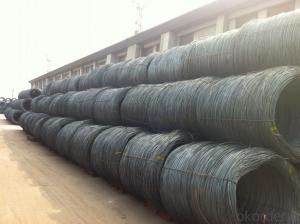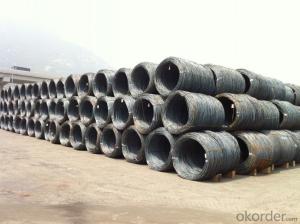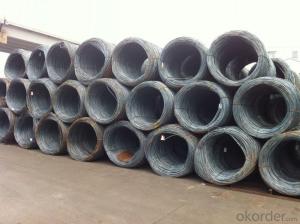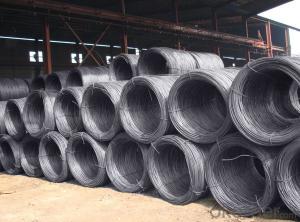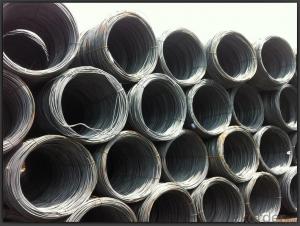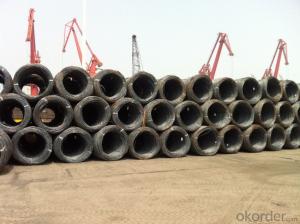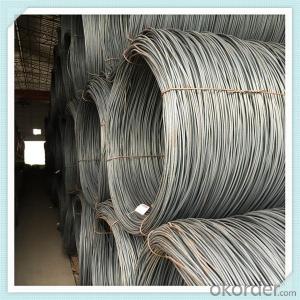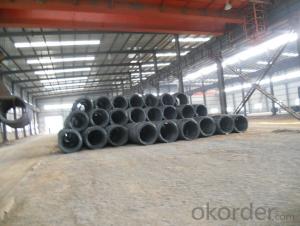SAE1008 Wire Rods Best Quality and Price and Hot Rolled
- Loading Port:
- Tianjin
- Payment Terms:
- TT OR LC
- Min Order Qty:
- 25 m.t.
- Supply Capability:
- 20000 m.t./month
OKorder Service Pledge
OKorder Financial Service
You Might Also Like
Specification
Grade: SAE1008 Standard: ASTM
Diameter: 5.5mm, 6.5mm, 7mm, 8mm, 9mm, 10mm, 11mm, 12mm
Alloy or Not: Alloy
Technique: Hot Rolled Place of Origin: China Mainland
Chemical Composition:
Please kindly find our chemistry of our material based on SAE1008 as below for your reference:
Grade | Chemical Composition (%) | |||||
C | Mn | S | P | Si | B | |
SAE1008 | 0.10max | 0.30-0.50 | 0.050max | 0.040max | 0.30max | 0.0008min |
Mechanical properties | ||||||
Yield strength(N/mm2) | Tensile strength(N/mm2) | Elongation (%) | ||||
≥195 | 350-380 | ≥32 | ||||
Usage and Applications of Wire Rod:
After hot-rolled the products shaped into coil and delivery as finished product, including round, square,rectangular, hexagonal and so on. Since most of the products are round, it is generally called wire rod. Carbon steel wire rod is widely used in construction and manufacturing. Carbon steel wire rod is mainly used for reinforcement of reinforced concrete and welded structure or reprocessed (roberts , nail, etc.) materials, especially used to produce wire drawing, welding electrode, nails, spring, electronic, precise machinery parts and so on.
Packaging & Delivery of Wire Rod:
Packaging Detail: products are packed in coil and then shipped by container or bulk vessel
Each coil weight: About 2.05MT
Delivery Detail: within 45 days after received deposit or LC.
Label: to be specified by customer, generally, each bundle has 1-2 labels
Trade terms: FOB, CFR, CIF
FAQ:
Q1: How soon can we receive the product after purchasement?
A1: Within three days of placing an order, we will begin production. The specific shipping date is dependent upon international and government factors, but is typically one month.
Q2: How do you guarantee the quality of our products?
A2: We have established an advanced quality management system which conducts strict quality tests at every step, from raw materials to the final product. At the same time, we provide extensive follow-up service assurances as required.
Q3: Why buy Materials & Equipment from OKorder.com?
A3: All products are carefully selected from China's most reliable manufacturing enterprises. Through its ISO certifications, OKorder.com adheres to the highest standards and a commitment to supply chain safety and customer satisfaction.
Images of Wire Rod
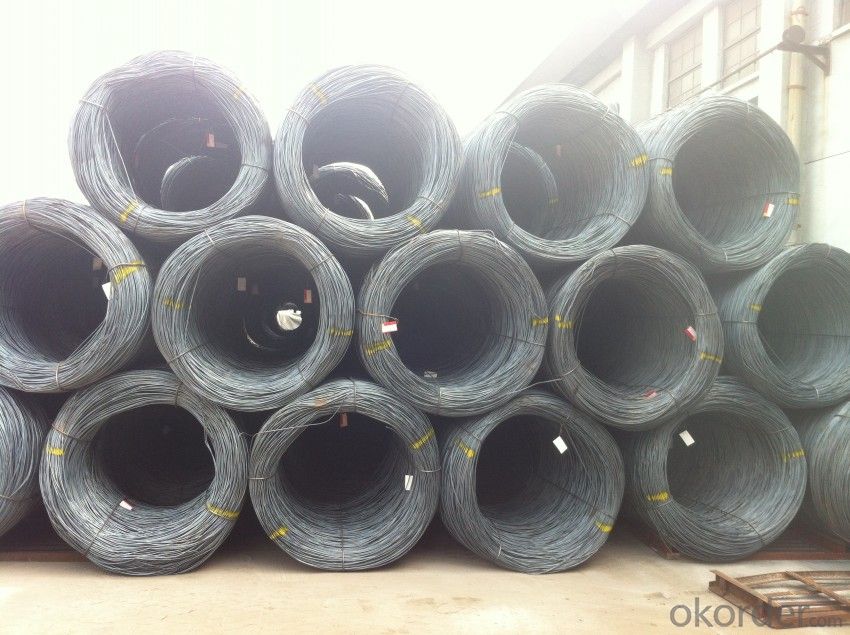
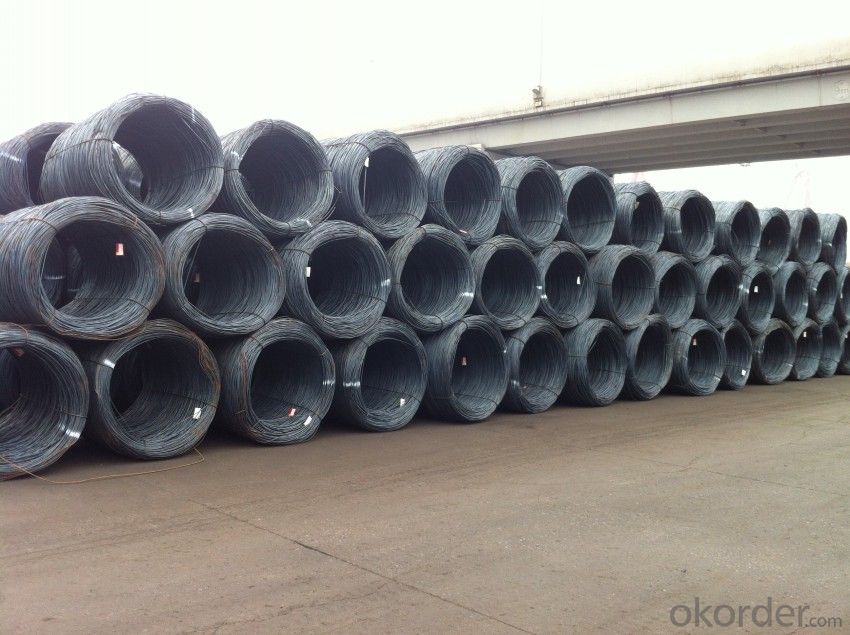
- Q: What are the different types of steel wire rod finishes for improved lubricity?
- There are several types of steel wire rod finishes that can be used to enhance lubricity. These include zinc coating, phosphate coating, galvanizing, and polymer coatings. Zinc coating provides a protective layer and reduces friction, while phosphate coating improves surface adhesion for lubricants. Galvanizing involves applying a layer of zinc to the surface, which increases lubricity. Polymer coatings create a smooth and low-friction surface, further enhancing the lubricity of the steel wire rod.
- Q: How are steel wire rods used in the production of wire springs for various mechanical applications?
- Steel wire rods are used in the production of wire springs for various mechanical applications as they serve as the primary raw material. These rods undergo a series of manufacturing processes such as drawing, coiling, and heat treatment to transform them into wire springs. The wire rods provide the necessary strength, durability, and elasticity required for the springs to function effectively in applications such as automotive suspensions, industrial machinery, and furniture.
- Q: How is the diameter of a steel wire rod determined?
- The diameter of a steel wire rod is typically determined using a measuring instrument, such as a micrometer or caliper, which allows for precise measurements. The instrument is applied to the wire rod at multiple points along its length, and the average diameter is calculated based on these measurements.
- Q: How is the corrosion resistance of steel wire rod evaluated?
- The corrosion resistance of steel wire rod is typically evaluated through various tests and assessments. These may include conducting salt spray tests to simulate harsh environmental conditions, measuring the rate of corrosion using electrochemical techniques like polarization resistance or linear polarization, and analyzing the composition and microstructure of the wire rod to determine its susceptibility to corrosion. Additionally, real-world exposure tests and long-term monitoring are often carried out to assess the overall performance and durability of the steel wire rod in corrosive environments.
- Q: What are the main factors influencing the choice of steel wire rod order frequency?
- There are several key factors that influence the choice of steel wire rod order frequency. 1. Demand and market conditions: The current demand for steel wire rods in the market plays a significant role in determining the order frequency. If there is a high demand for steel wire rods, companies may need to place more frequent orders to meet customer requirements and maintain inventory levels. Additionally, market conditions such as price fluctuations and availability of supply can also influence the order frequency. 2. Production capacity and lead time: The production capacity of the steel wire rod supplier and the lead time required to deliver the orders can impact the order frequency. If a supplier has limited production capacity or a longer lead time, companies may need to place larger and less frequent orders to ensure a continuous supply of steel wire rods. 3. Inventory management: The existing inventory levels and storage capacity of the company also affect the order frequency. If a company has limited storage space or wants to minimize inventory holding costs, they may choose to place more frequent orders in smaller quantities rather than large bulk orders. 4. Cost considerations: The cost of steel wire rods, including the purchase price, transportation, and any applicable taxes or duties, is another significant factor influencing the order frequency. Companies may analyze the cost of holding inventory versus the cost of frequent ordering to determine the most cost-effective approach. 5. Supplier relationships: The relationship between the company and the steel wire rod supplier can impact the order frequency. If there is a strong and reliable partnership, companies may have more flexibility in adjusting the order frequency based on changing market conditions or business needs. Overall, the main factors influencing the choice of steel wire rod order frequency are demand and market conditions, production capacity and lead time, inventory management, cost considerations, and supplier relationships. Companies need to consider these factors in their decision-making process to ensure a steady and efficient supply of steel wire rods.
- Q: How is steel wire rod stored at the customer's site?
- Steel wire rod is typically stored at the customer's site in large coil racks or on flatbeds. These storage methods ensure that the wire rod remains secure and organized, allowing for easy access when needed.
- Q: How is steel wire rod used in the production of suspension springs for railway vehicles?
- Steel wire rod is used in the production of suspension springs for railway vehicles as it provides the necessary strength and durability required to withstand the heavy load and constant vibrations experienced during train operations. The wire rod is carefully shaped and coiled to create the suspension springs, which are then installed in the suspension system of railway vehicles to absorb shocks, maintain stability, and ensure a smooth and comfortable ride for passengers.
- Q: How is steel wire rod used in the production of wire mesh baskets for industrial applications?
- Steel wire rod is used in the production of wire mesh baskets for industrial applications as it serves as the primary material for manufacturing the wire mesh. The rod is first drawn down to the desired diameter, then woven or welded to create the mesh structure of the basket. This strong and durable wire mesh provides the necessary strength and stability required for holding and organizing various items in industrial settings.
- Q: What are the common production processes for sulfur-coated steel wire rod?
- The common production processes for sulfur-coated steel wire rod include wire drawing, pickling, coating with sulfur, and heat treatment.
Send your message to us
SAE1008 Wire Rods Best Quality and Price and Hot Rolled
- Loading Port:
- Tianjin
- Payment Terms:
- TT OR LC
- Min Order Qty:
- 25 m.t.
- Supply Capability:
- 20000 m.t./month
OKorder Service Pledge
OKorder Financial Service
Similar products
Hot products
Hot Searches
Related keywords
